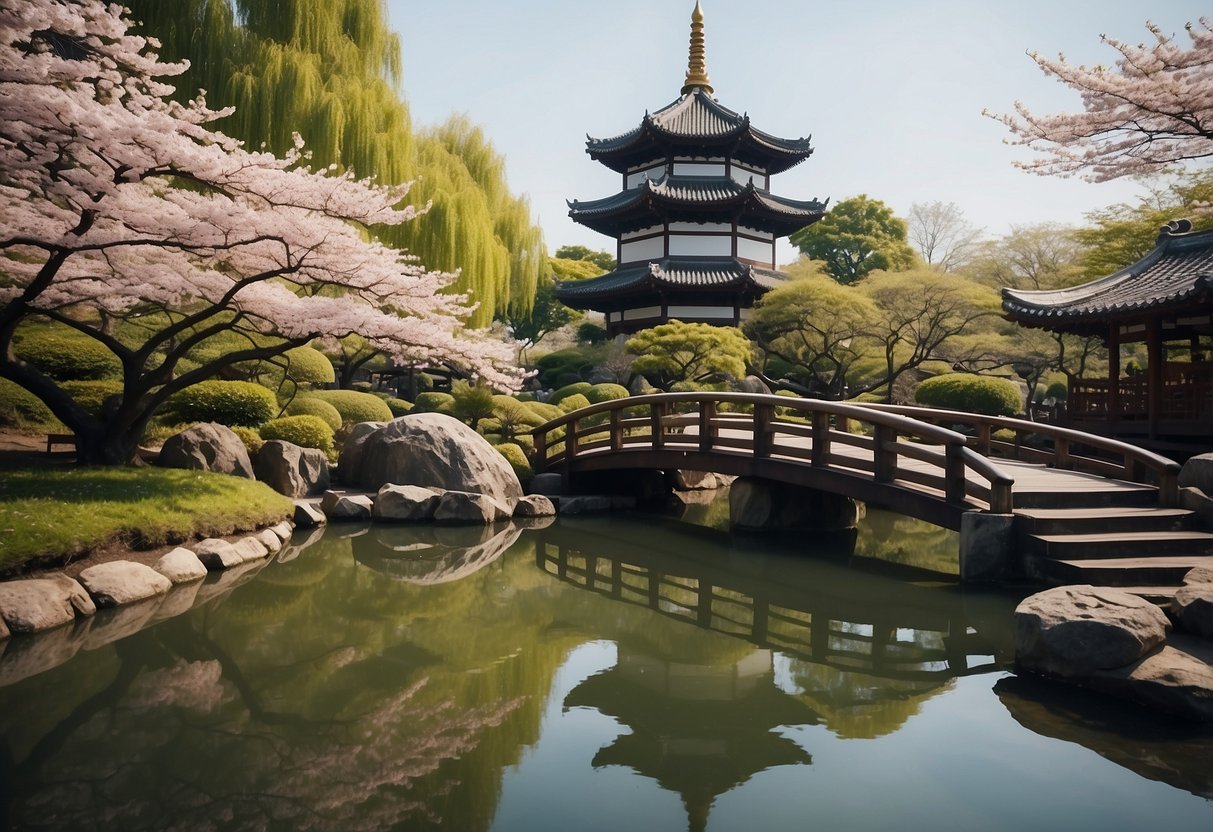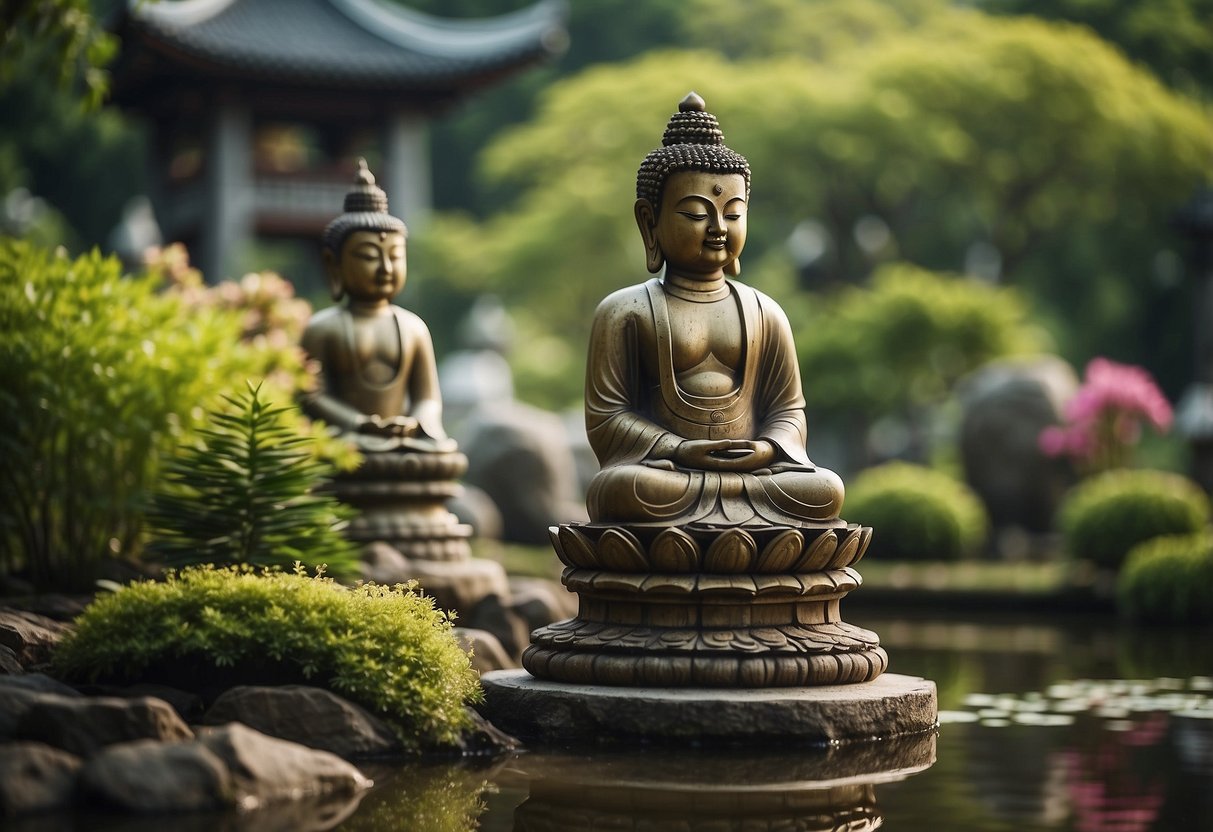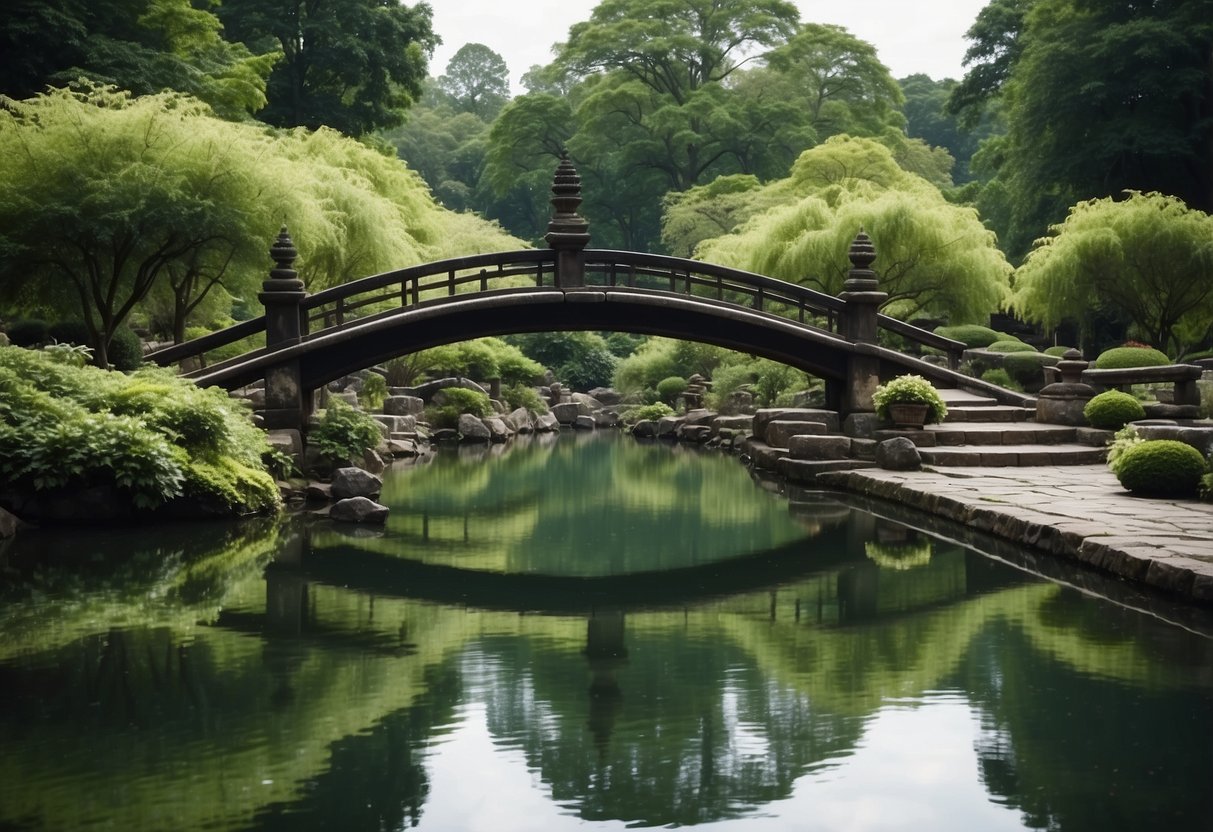Asian Garden Ideas: Transform Your Outdoor Space with Tranquil Designs
Creating an Asian garden can transform your outdoor space into a tranquil retreat. By combining natural elements like water, plants, and rocks, you can achieve a serene environment that promotes relaxation and reflection. These gardens often draw from Buddhist, Shinto, and Taoist philosophies to inspire peaceful contemplation.

What makes an Asian garden unique is its balance between different elements of nature, creating harmony that is both pleasing to the eye and soothing to the soul. Whether you have a small backyard or a large area to work with, there are countless ways to incorporate Asian design principles to suit your space. Let’s explore some beautiful ideas that can help you create your own haven of tranquility.
1) Japanese Stone Lanterns

You can add a traditional touch to your garden with Japanese stone lanterns. These lanterns, known as Ishidōrō, have roots going back over a thousand years.
Stone lanterns bring calmness and beauty to any garden. They are often placed near pathways, ponds, or among plants.
Consider Japanese stone lanterns for their timeless style and cultural significance. They not only light up paths but also add an artistic element to the space. For more ideas, visit Japanese Stone Garden Lanterns.
2) Zen Sand Gardens

Zen sand gardens, known as karesansui, focus on simplicity and minimalism. These gardens use sand, gravel, and stones to create calming scenes.
You can create patterns in the sand with a rake. The lines often represent waves in water.
Add rocks to represent islands or mountains. Thoughtful placement of these elements can make the garden feel balanced and serene.
Using a tray with raised edges for a mini Zen garden allows you to bring this peaceful style indoors. Place a small pagoda or lantern for a more authentic touch.
3) Bamboo Fencing

Bamboo fencing is a great way to add a touch of Asian elegance to your garden. It not only looks beautiful but is also quite functional. You can use it to create privacy or to define different areas in your garden.
You start with main posts, spaced about six feet apart, to support the bamboo canes. Depending on the style, tie the canes with knots for extra stability.
Pair smaller vertical canes with thicker bamboo posts for a more refined look. A Japanese bamboo kumo fence is a stylish option that combines bamboo with wood framing.
4) Koi Ponds

Koi ponds are a fantastic way to add tranquility to your garden. These ponds are home to koi, beautiful ornamental fish known for their vibrant colors and soothing movements.
You can create a serene atmosphere by adding plants and stones around the pond. Various colorful koi fish will make your pond a lively and calming focal point.
Consider building a bridge over the pond. This not only enhances the aesthetic but also offers a great view of the koi swimming below, creating a stunning visual experience.
5) Asian Water Features

Water features are a key element in Asian gardens. They bring tranquility and a sense of nature to your space. You can include cascades, streams, and waterfalls to create dynamic movement.
Another idea is to add a serene koi pond or a simple rock water feature. These can be paired with stone lanterns or gravel pathways to enhance the peaceful atmosphere.
Using still water, like a reflecting pool, can also add a calming effect. It mirrors the sky and plants, making your garden feel more expansive.
6) Pagoda Statues

Pagoda statues can transform any garden into a serene and peaceful place. They are known for their unique design and rich symbolism, which can bring a touch of Zen to your outdoor space.
Adding pagoda statues next to bonsai trees creates an authentic Japanese-inspired look. These statues make fantastic focal points and can elevate the entire garden’s atmosphere.
Consider materials like stone, wood, or metal for your pagoda statues. Each material brings its own charm and is durable enough to withstand outdoor conditions. This makes a lasting impression on anyone who visits your garden.
7) Bonsai Trees

Bonsai trees are a beautiful addition to any Asian garden. These miniature trees are grown in containers and carefully pruned to maintain their small size.
Originating from Japan, bonsai trees symbolize harmony and balance. They have a rich cultural history and offer a sense of tranquility.
Popular bonsai trees include the Fukien Tea tree, which thrives indoors in warm weather. For more bonsai tree options, check out these popular bonsai trees.
Creating a bonsai tree takes patience and skill, but the result is a stunning, living piece of art.
8) Cherry Blossom Trees

Adding cherry blossom trees to your garden brings a touch of magic. These trees are famous for their stunning flowers. The Fuji cherry tree has dainty white flowers that look like something out of a fairy tale.
You might also like the weeping cherry blossoms. With their umbrella-shaped crowns, they make a striking focal point. They are easy to grow and rarely need pruning.
Imagine your garden filled with 300 types of Japanese cherry blossoms! This variety ensures you find the perfect match for your space.
9) Stepping Stones

Stepping stones add charm and function to your garden. They guide visitors through the space and create a sense of adventure.
You can choose from various materials like natural stones, concrete, or even mosaic tiles. Each option offers a unique look and feel.
A curving path with stepping stones can make your garden more inviting and lead you to special spots like a pond or a sculptural focal point.
10) Ornamental Grasses

Ornamental grasses add elegance and movement to your Asian garden. Miscanthus sinensis, also known as Chinese Silver Grass, is a great choice. It’s easy to grow, requires little maintenance, and looks stunning year-round.
Another excellent option is Hakonechloa macra, or Japanese forest grass. It softens the edges of paths and thrives in partial shade. For striking color, consider Ophiopogon planiscapus ‘Nigrescens,’ which has beautiful purple-black leaves.
Design Principles for Asian Gardens

Creating an Asian garden involves balancing natural and man-made elements and integrating water features to enhance beauty and tranquility.
Balancing Elements
In Asian gardens, harmony between different components is crucial. You should use rocks, plants, and water in a balanced manner to create a natural look. For instance, placing a large rock near a small pond can emphasize the water, making the garden feel more serene.
Trees and Shrubs: Select trees like Japanese maple and shrubs that fit the scale of your garden.
Pathways: Use simple, curved pathways to guide visitors through the garden. Avoid straight lines to mimic natural landscapes.
Statues and Lanterns: Incorporate statues or lanterns thoughtfully. These should complement, not overshadow, the natural elements. Balance is key, and each item should add to the tranquility and visual interest of the garden.
Use of Water Features
Water features like ponds, streams, and fountains are integral to Asian gardens. They symbolize calmness and provide soothing sounds that enhance relaxation.
Ponds: Small ponds with koi fish can bring life and movement to the garden. Surround them with rocks and plants to create a natural look.
Streams and Waterfalls: Including a stream or waterfall can add to the sense of tranquility. The flowing water creates a soothing atmosphere and can help mask unwanted noises.
Fountains: Simple bamboo fountains can be a stylish addition. They should blend with the garden’s design to keep the natural feeling intact.
Maintenance: Regular maintenance of water features is essential. Clean the water and ensure pumps are working to keep the features functional and beautiful.
Harmonizing these elements will make your garden a peaceful retreat.
Cultural Influences on Asian Garden Design

Asian garden designs are rich in history and cultural significance. They take their shapes from various influences, particularly from Japan and China, each bringing unique elements and philosophies to the beauty of these landscapes.
Japanese Zen Gardens
Japanese Zen gardens draw heavily from Buddhist, Shinto, and Taoist philosophies. They aim to create spaces for peaceful contemplation. The use of water, rocks, and plants is essential. Simple, clean lines are a hallmark, emphasizing natural beauty and tranquility.
You might see features like stones arranged in a specific pattern, often surrounded by raked gravel to symbolize water. This minimalist approach is clearly seen in places like the Ryoan-ji Temple in Kyoto, where stone gardens use moss circles to add a touch of nature without overwhelming the viewer.
Chinese Garden Traditions
Chinese gardens have a centuries-old tradition, deeply influenced by literary and philosophical ideas. These gardens focus more on creating a natural landscape on a smaller scale, mirroring the vastness of nature. Elements like pavilions, rockeries, and meandering pathways are common.
In these gardens, every aspect is thought out to create a harmonious balance, aiming to reflect the natural world. You might encounter features such as large rocks symbolizing mountains or ponds representing lakes, all arranged to form a seamless blend of art and nature. The influence of Chinese garden design also extends to Japanese gardens, showing the deep interconnectedness of Asian garden aesthetics.







